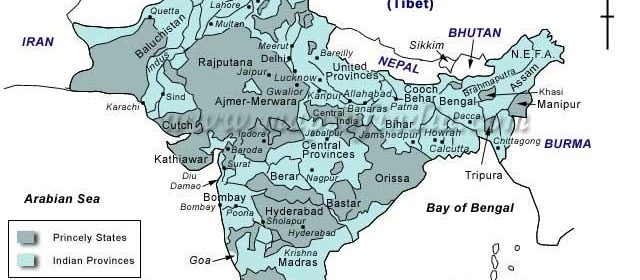Can we blame Congress for partition?

Partition, reluctantly accepted by Congress, was of course a sad tragedy, but would the only other alternative have been any better? Or would it have led to an even more divided and Balkanised Indian Subcontinent?
Also, by joining hands with Muslim League during the World War II period, and boycotting the Quit India movement, the Hindu Mahasabha led by Savarkar was itself as culpable as the Muslim League for both the rise in communalism, and increased influence of the Muslim League
Events leading to 1947
Before the partition, it is important to understand why and how such a situation arose, that it became impossible to stop partition.
- Congress did exceptionally well in the 1937 elections. The Muslim League failed to win a majority even of the Muslim seats in any of the provinces where Muslims held a majority. The Congress and its allies formed the government even in NWFP, where the Muslim League won no seats despite the fact that almost all residents were Muslim. Overall, Muslim League won only 106 seats out of a total of 1585.
- Congress is also said to have displayed some typical hubris of the winner, and refused to accommodate the Muslim League in coalition governments. As per several authors, this may have resulted in some resentment, boosting the support for partition amongst Muslim league’s leadership, in particular MA Jinnah. According to Jaswant Singh, in his book on Jinnah, “the events of 1937 had a tremendous, almost a traumatic, effect upon Jinnah”
- It is interesting to note that it is only after 1937 that MA Jinnah started showing a much deeper influence of Iqbal, the ideologue poet who had been talking of Pakistan and the Two Nation Theory since 1930.
- The important point to note from the 1937 election results is that Congress still enjoyed popular support even amongst Muslims at that time. The Muslim League leadership did not have enough political influence to turn their demands and ideas into reality.
- Muslim League leadership needed to increase communal polarisation sufficiently in order to get Muslims to get behind them, and support the Two Nation Theory – the idea that Hindus and Muslims are two separate nations, and cannot stay together.
- If Indian society had displayed communal harmony, Hindus and Muslims stayed together, that would have never allowed the Two Nation Theory to take hold. This needed some clever, tolerant and responsible behaviour from the leaders of majority Hindus to inspire confidence and security amongst the minority.
- However, “hot-heads” like Savarkar of Hindu Mahasabha himself were also talking about Two Nation theory, and made many very communal speeches. The poisonous and communal behaviour of Hindu Right Wing “Fringe”, including that from some leaders from Congress itself too, during this period may have been the bigger reason for anxieties in Muslims that were exploited by the Muslim League.
- Congress resigned from the Government after the world war started in September 1939, and India was also made to join it by the British Viceroy, without consulting the Indian representatives.
- Hindu Mahasabha saw a window of opportunity to enhance its power. It decided to form coalition ministries with the Muslim League (which too opposed to the Quit India Movement) in the provinces of Bengal, NWFP and Sindh.
- I am not exactly sure what Hindu Mahasabha, led by the supposed genius Savarkar, gained from this opportunistic deal, but it certainly provided legitimacy, power and an opportunity to grow, to the Muslim League.
- After Quit India movement in 1942, much of Congress leadership was in jails. Both Muslim League and the Hindu Mahasabha had collaborated with British war efforts, boycotted the Quit India movement, and their leaders were out, freely expanding their base by appealing to communal feelings.
- In March 1943, Sindh Government became the first Provincial Assembly of the sub-continent to pass an official resolution in favour of the creation of Pakistan. In spite of the Hindu Mahasabha’s avowed public opposition to any political division of India, the Mahasabha Ministers of the Sindh government did not resign.
- Muslim League won a majority in Muslim majority provinces of Bengal, Punjab and Sind in 1946 elections, and significantly improved its position, winning 425 seats to Congress’s 923.
- It is a common strategy for all communal parties – their popularity increases whenever there are riots.
- By 1946, Muslim league leaders were deliberately starting riots in Bengal, from Calcutta to Noakhali, with the intention of inviting Hindu reprisals, and increase polarisation all over India, in order to force a large number of Muslims to abandon supporting Congress, and vote for Muslim League.
- Logically thinking, only a Gandhian response could have ever countered this strategy of the Muslim League leadership. A jingoistic response of an eye for an eye, increasing the cycle of hatred, is exactly what the Muslim League leaders wanted. An intelligent person never does what his enemy wants him to do.
- In a short span of time, the rise in communal polarisation had been very rapid. Gandhi tried his best to stop this madness, but even a leader of the his stature had to spend months trying to stop killing in Bengal.1
- The only Real Alternative Congress was left with, was the Cabinet mission plan. This envisaged a loose federation with very weak centre.
Cabinet mission plan
The main points of the Cabinet mission plan were:
- There would be a union of India comprising both British India and the Indian States that would deal with foreign affairs, defense and communications. The union would have an Executive and a Legislature.
- All residuary powers would belong to the provinces.
- All provinces would be divided into three sections. Provinces could opt out of any group after the first general elections.
This would, most likely, have caused a totally balkanized Indian subcontinent by now. Compared to that, partition was arguably a better option.
